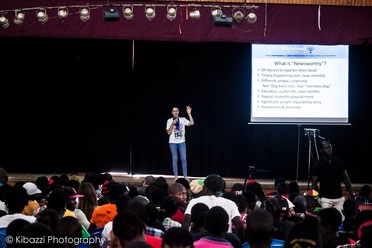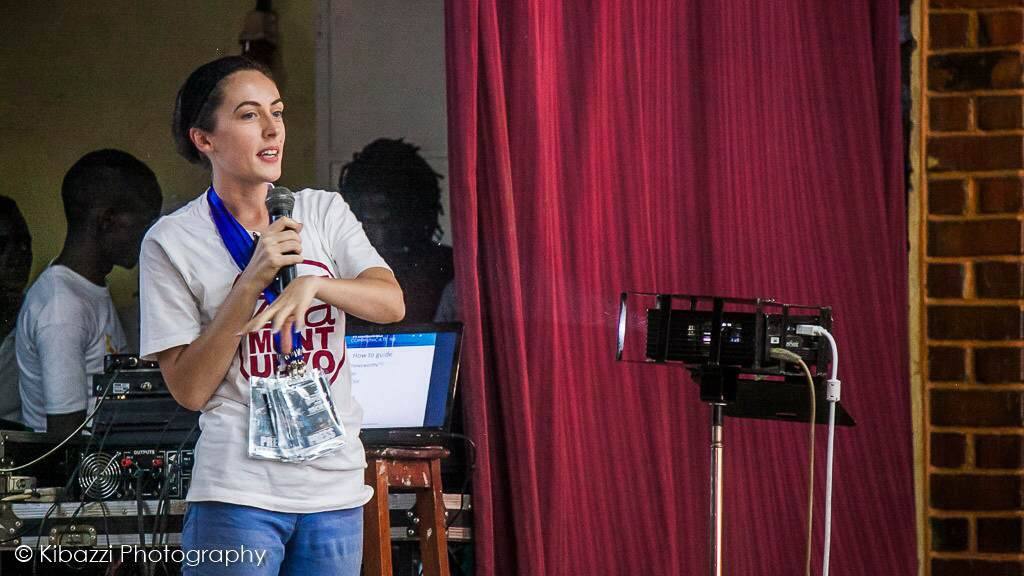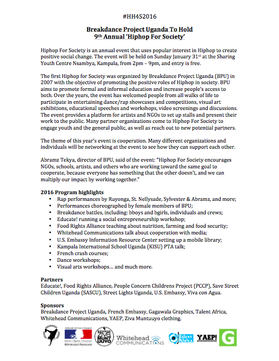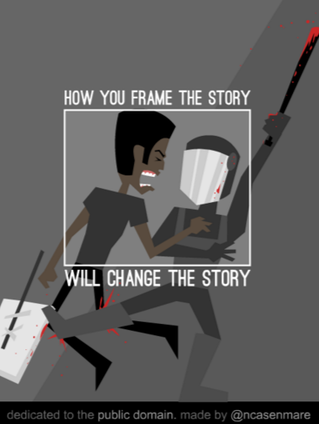At Hiphop For Society 2016, I gave a short presentation on how to cooperate with media to get coverage for your event or project, sharing some of what I’ve learned in keeping with the annual theme of “cooperation.”
Honest self-feedback: I talked too fast and did not properly scale my communication down to the general audience, but a few people contacted me afterward to ask for a written version, so here goes…
This quick How-To Guide to cooperating with media includes the following:
Honest self-feedback: I talked too fast and did not properly scale my communication down to the general audience, but a few people contacted me afterward to ask for a written version, so here goes…
This quick How-To Guide to cooperating with media includes the following:
- What is “Newsworthy”?
- Preparation
- The Media List
- Scheduling
- The Press Release
- Framing a Story

What is “Newsworthy”?
Cooperation requires mutual benefit, right? When pitching a story to the media, it’s pretty important to make sure your story is actually interesting to them and worth sharing as “news.”
What is new, different or surprising about your story? There’s an old saying that it’s nothing new when a dog bites a man, but when a man bites a dog, that is “news!”
There are a few other elements that tend to make up a “newsworthy” story.
Timeliness: It has to be happening soon, right now, or very recently, and this is truer than ever these days, when news is produced 24/7 and people are used to being in the know, right now!
Share-Worthy: does your story include useful information? Is it educative? Is it interesting? Is it the kind of knowledge that people would want to share with friends on their Facebook walls?
Topical: Does your story fit into some larger trend? Mothers tend to get more media attention around Mother’s Day. Political messages get more column inches during an electoral campaign. If your story relates to an ongoing trend, ride that wave.
Significance: How important is your story to the people who will read or watch it? Is it local? Are there known people involved? When the audience is significantly impacted by a story, that is “newsworthy.”
Cooperation requires mutual benefit, right? When pitching a story to the media, it’s pretty important to make sure your story is actually interesting to them and worth sharing as “news.”
What is new, different or surprising about your story? There’s an old saying that it’s nothing new when a dog bites a man, but when a man bites a dog, that is “news!”
There are a few other elements that tend to make up a “newsworthy” story.
Timeliness: It has to be happening soon, right now, or very recently, and this is truer than ever these days, when news is produced 24/7 and people are used to being in the know, right now!
Share-Worthy: does your story include useful information? Is it educative? Is it interesting? Is it the kind of knowledge that people would want to share with friends on their Facebook walls?
Topical: Does your story fit into some larger trend? Mothers tend to get more media attention around Mother’s Day. Political messages get more column inches during an electoral campaign. If your story relates to an ongoing trend, ride that wave.
Significance: How important is your story to the people who will read or watch it? Is it local? Are there known people involved? When the audience is significantly impacted by a story, that is “newsworthy.”

Preparation
Before contacting the media, get the relevant facts together. This may be obvious to a lot of people, but make sure you include the what, when, where, who, how much, your history and objectives, and why it is news.
Consider what you’re reaching out to the media for in the first place. Why do you want media coverage? What are your objectives? What do you want people to do with this information? Make sure you include whatever someone would need to act.
Before contacting the media, get the relevant facts together. This may be obvious to a lot of people, but make sure you include the what, when, where, who, how much, your history and objectives, and why it is news.
Consider what you’re reaching out to the media for in the first place. Why do you want media coverage? What are your objectives? What do you want people to do with this information? Make sure you include whatever someone would need to act.

The Media List
It helps to have a contact list of media people – from newspapers to TV, radio, blogs and social media influencers – but be careful not to abuse it! First, make sure the media you contact are relevant. Don’t waste a business reporter’s time on an arts story (unless you have a great business angle). A lot of people don’t mind emailing or whatsapp-spamming all their contacts whenever they want to get the word out, but I prefer quality over quantity. Inform those who are really interested and will make an effort to share your story with the appropriate audience. Being mindful of people’s interests is important, especially because people will tune you out if they get used to you broadcasting stuff they don’t care about.
It helps to have a contact list of media people – from newspapers to TV, radio, blogs and social media influencers – but be careful not to abuse it! First, make sure the media you contact are relevant. Don’t waste a business reporter’s time on an arts story (unless you have a great business angle). A lot of people don’t mind emailing or whatsapp-spamming all their contacts whenever they want to get the word out, but I prefer quality over quantity. Inform those who are really interested and will make an effort to share your story with the appropriate audience. Being mindful of people’s interests is important, especially because people will tune you out if they get used to you broadcasting stuff they don’t care about.

Scheduling
Carol Beyanga, managing editor at the Daily Monitor, recommends that you inform media early in the process.
In the case of an event, I would recommend you schedule your media cooperation something like this…
Keep in mind that media folks tend to be at their busiest around noon, when deadlines loom, so make sure to get out information well before then and don’t expect them to pay you much attention during their rush hour.
Carol Beyanga, managing editor at the Daily Monitor, recommends that you inform media early in the process.
In the case of an event, I would recommend you schedule your media cooperation something like this…
- Inform media contacts of the basic information ASAP (maybe a month in advance): date, time, location, event name, etc.;
- Send out a first press release with background information more than 1 week in advance to allow for promotional stories;
- With a big story, you can send out multiple press releases that each focus on a different element (profiling people involved, the making of, issues addressed, etc.);
- Create a unique hashtag to track online sharing, like #HH4S2016;
- Make sure to be helpful if media are at your event: set them up with great interviews and answer any questions they may have;
- Send out a sum-up press release with photos the night or morning after the event.
Keep in mind that media folks tend to be at their busiest around noon, when deadlines loom, so make sure to get out information well before then and don’t expect them to pay you much attention during their rush hour.
| The Press Release There are plenty of examples of press releases on my Newsletter page here. In my experience, a typical press release includes:
|
| Framing a Story There are many ways to tell a story, depending on how you frame it. It's natural to place a frame around the information, sharing some things and not others. The media does this all the time. Have you noticed? Try to influence how your story is told. Can you see how in this picture (<- left) the story within the frame is not the same as the story that has been cut out of the frame? It’s up to you how your story will be understood, depending on what elements you highlight and which ones you leave out. For example, the Hiphop For Society 2016 event could be framed as entertainment or as education, or both. You could frame it as an event for Ugandan youth, or you could highlight participants of different ages, or showcase how it empowers women and girls. You could make the story Ugandan-centric, or point out how it attracts a multi-cultural crowd. The way you frame your story should be informed by your original media objectives, and an effort to make it newsworthy. |
I hope you found some value in this collection of thoughts. Thanks to everyone who contributed on Twitter and all of those who taught me what I know! I welcome comments if you have your own ideas.




